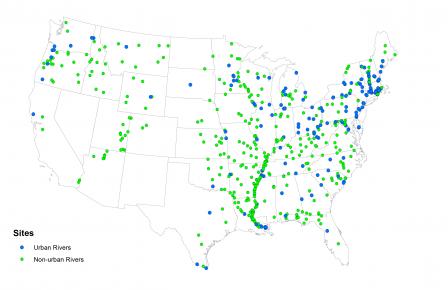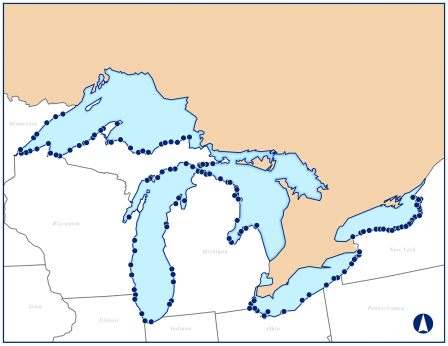Studies of Fish Tissue Contamination
EPA collaborated with federal agencies, states and other partners to conduct a series of fish contamination studies. These studies provide data on concentrations of a variety of chemicals in fish tissue.
You can also skip the background information on these studies and view their results and data, as well as data from other fish tissue collection efforts. See: Fish Tissue Data Collected by EPA
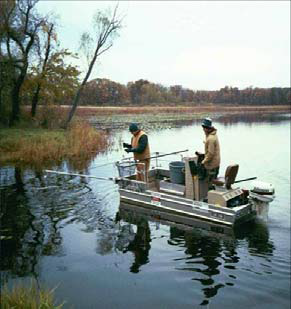
National Study of Chemical Residues in Lake Fish Tissue
This study was the first statistically‐based freshwater fish contamination study conducted on a national level. The purpose of this study was to generate data to protect the health of people and wildlife that eat fish from lakes. This website provides:
- Information on data
- Study analysis methodology
- A summary of the study results
- Links to the study results in different formats (e.g., fact sheets, executive summary, etc.)
The study provided data on concentrations of persistent, bioaccumulative and toxic chemicals in fish. EPA began planning this study in 1998 and published study results for the following conventional pollutants in 2009:
- mercury
- PCBs
- pesticides
- dioxins
- More information on National Study of Chemical Residues in Lake Fish Tissue
- Results and Data
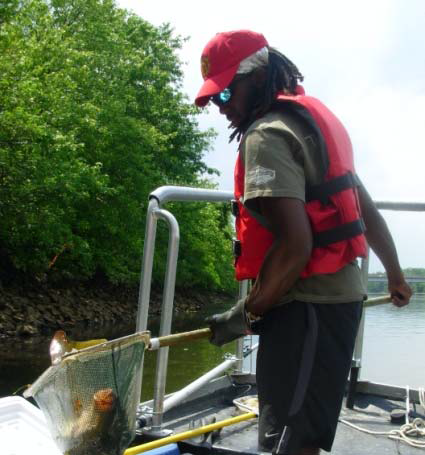
National Rivers and Streams Assessment Fish Tissue Study
In 2008, EPA began a two-year statistical survey of the condition of flowing waters in the United States. The National Rivers and Streams Assessment (NRSA) was designed to meet the following objectives:
- Assess the condition of the Nation’s rivers and streams
- Establish a baseline to compare future rivers and streams surveys for trends assessments
- Evaluate changes in condition from the 2004 Wadeable Streams Assessment
- Help build State and Tribal capacity for monitoring and assessment and promote collaboration across jurisdictional boundaries
The core indicators for this survey (for example, water chemistry measurements, physical habitat assessment, and characterization of benthic macroinvertebrate and fish assemblages) provided data for an ecological assessment of U.S. rivers and streams. More information about the NRSA ecological assessment.
The 2008-09 NRSA included additional studies to assess potential impacts to human health. The NRSA Fish Tissue Study measured the levels of chemical contaminants in fish fillet samples to evaluate the potential health impacts for people who consume fish.
This study was designed to be the first statistically based national assessment of contaminants in fish from U.S. rivers. It also provided an opportunity for EPA to conduct the first national-scale assessment of perfluorinated compounds in freshwater fish from urban rivers.
Sampling Design
Sampling locations for this study were selected from urban and nonurban river segments across the lower 48 states. Rivers that qualified as potential study sites were 5th order or greater in size (based on Strahler stream order) with a permanent fish population and flowing water during the study period from May through September.
Only freshwater portions of tidal rivers were included in the study. A statistically representative set of 542 river sites (164 urban river segments and 378 nonurban river segments) were sampled for the NRSA Fish Tissue Study.
Fish Sample Collection
Field crews collected fish samples from the 542 NRSA fish tissue sampling locations using primarily electrofishing gear. A routine fish composite sample consisted of five fish that met the following criteria:
- All are of the same species
- All satisfy legal requirements of harvestable size for the sampled lake, or at least be of consumable size if no legal harvest requirements are in effect
- All are of similar size, so that the smallest fish in the composite sample is not less than 75% of the total length of the largest fish in the composite sample
- All are collected at the same time
Thirty-nine species of fish were collected for the NRSA Fish Tissue Study. The three most frequently caught species included smallmouth bass, largemouth bass, and channel catfish. The table provides a summary of the types of fish collected for the study.
Types of Fish Collected for the Study and the Lakes they Came from
| Species | Urban Sites | Non-Urban Sites | Total Composites |
|---|---|---|---|
| Smallmouth Bass | 56 | 64 | 120 |
| Largemouth Bass | 41 | 66 | 107 |
| Channel Catfish | 17 | 58 | 75 |
| Flathead Catfish | 8 | 35 | 43 |
| Blue Catfish | 3 | 30 | 33 |
| Spotted Bass | 2 | 16 | 18 |
| Mountain Whitefish | 2 | 13 | 15 |
| Rainbow Trout | 3 | 12 | 15 |
| Others | 32 | 84 | 116 |
| Total Composites | 164 | 376 | 542 |
Fillet Tissue Analysis
The fish sampling procedures required field crews to ship whole fish to a laboratory responsible for preparation of fillet tissue samples. Trained laboratory staff filleted the fish (removing scales, but retaining the skin and the belly flap on each fillet) and homogenized the fillet tissue in a strictly controlled environment to avoid contaminating the fish tissue samples.
Fillet tissue aliquots were prepared from each fish sample for distribution to analytical laboratories for chemical analysis. Fillet tissue prepared from the fish samples were analyzed for the following chemicals:
- Mercury (total)
- Selenium (total)
- Polychlorinated biphenyls or PCBs (21 congeners)
- Polybrominated diphenyl ethers or PBDEs (8 congeners)
- Pesticides (21 compounds)
- Perfluorinated compounds or PFCs (13 compounds)
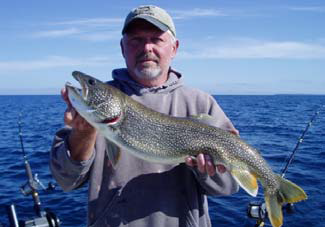
National Coastal Condition Assessment/Great Lakes Human Health Fish Tissue Study
In 2010, EPA initiated an expanded statistical survey of the condition of U.S. coastal waters including the Great Lakes. This National Coastal Condition Assessment (NCCA) was designed to meet the following objectives:
- Assess the ecological condition of the Nation’s coastal and estuarine waters at a national scale and the Great Lakes at a regional scale
- Identify the relative importance of factors impacting coastal, estuarine, and Great Lakes water quality
- Evaluate changes in ecological condition from previous National Coastal Assessments dating back to 2000
The Great Lakes ecological assessment involved collection of water, sediment and biological samples at 225 statistically selected nearshore sites (45 sites per lake) throughout the five Great Lakes. The samples from these sites provided data to evaluate ecosystem health, including dissolved oxygen and nutrient concentrations in water, benthic community condition and contaminant concentrations in sediments and whole fish tissue.
More information about the Great Lakes ecological assessment.
EPA conducted special studies in the Great Lakes under the NCCA in addition to the core ecological assessment. One of these studies, referred to as the Great Lakes Human Health Fish Tissue Study, added a human health component to the NCCA in the Great Lakes.
EPA’s Office of Water joined with the Great Lakes National Program Office (GLNPO) and the Office of Research and Development (ORD) to conduct this human health fish tissue study, which provided important new fish tissue data for the Great Lakes, including:
- The first statistically based data on chemicals in Great Lakes fish related to human health
- An important new set of data for omega-3 fatty acids in freshwater fish
Sampling Design
Sampling locations for this study were selected from nearshore areas of U.S. waters in the Great Lakes. The nearshore zone in the Great Lakes was defined as the region from the shoreline to a depth of 30 meters or to a distance of 5 kilometers in shallower waters of the Great Lakes.
A statistically representative subset of 157 sites distributed throughout the U.S. nearshore zone in the five Great Lakes (about 30 sites per lake) were sampled for the Great Lakes Human Health Fish Tissue Study.
Fish Sample Collection
Field crews collected fish samples from each of the 157 nearshore Great Lakes sampling locations using various gear (for example, gill nets or hook and line). A routine fish composite sample consisted of five fish that met the following criteria:
- All are of the same species
- All satisfy legal requirements of harvestable size for the sampled river, or at least be of consumable size if no legal harvest requirements are in effect
- All are of similar size, so that the smallest fish in the composite sample is not less than 75% of the total length of the largest fish in the composite sample
- All are collected at the same time.
Eighteen species of fish were collected for the Great Lakes Human Health Fish Tissue Study. The three most frequently caught species include lake trout, smallmouth bass and walleye. The table provides a summary of the types of fish collected for the study.
Types of Fish Collected for the Study and the Lakes they Came from
| Species | Superior | Michigan | Huron | Erie | Ontario | Total Composites |
|---|---|---|---|---|---|---|
| Lake Trout | 24 | 4 | 17 | 0 | 4 | 49 |
| Smallmouth Bass | 0 | 1 | 1 | 4 | 16 | 22 |
| Walleye | 0 | 3 | 1 | 12 | 4 | 20 |
| Chinook Salmon | 0 | 12 | 0 | 0 | 2 | 14 |
| Rainbow Trout | 0 | 3 | 4 | 0 | 1 | 7 |
| Round Whitefish | 6 | 1 | 0 | 0 | 0 | 7 |
| Freshwater Drum | 0 | 1 | 3 | 2 | 1 | 7 |
| Others | 8 | 6 | 3 | 9 | 4 | 30 |
| Total Composites | 38 | 31 | 29 | 27 | 32 | 157 |
Fillet Tissue Analysis
The fish sampling procedures required field crews to ship whole fish to a laboratory responsible for preparation of fillet tissue samples. Trained laboratory staff filleted the fish (removing scales, but retaining the skin and the belly flap on each fillet) and homogenized the fillet tissue in a strictly controlled environment to avoid contaminating the fish tissue samples.
Five fillet tissue aliquots were prepared from each fish sample for distribution to analytical laboratories for chemical analysis and one or more additional aliquots were retained for long-term tissue archive. Fillet tissue prepared from each of the 157 fish samples were analyzed for the following chemicals:
- Mercury (total)
- Polychlorinated biphenyls or PCBs (all 209 congeners)
- Polybrominated diphenyl ethers or PBDEs (52 congeners)
- Perfluorinated compounds or PFCs (13 compounds)
- Omega-3 fatty acids (5 fatty acids)
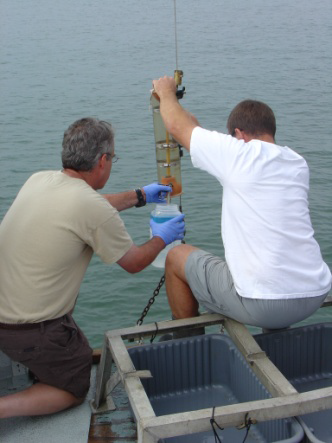
Contaminants of Emerging Concern (CECs)
EPA is investigating the presence of chemicals in fish for which the risk to human health and the environment is unknown. These contaminants of emerging concern include pharmaceuticals and personal care products, perfluorinated compounds (used in a wide variety of household and industrial products) and polybrominated diphenyl ethers (widely used as flame retardents).
For more information about what EPA is doing to improve our understanding on a number of CECs, see the fact sheets and study below.
Polybrominated Diphenyl Ethers (PBDEs)
Perfluorinated Compounds (PFCs)
- Contaminants of Emerging Concern in Fish: Perfluorinated Compounds (September 2013)
Pharmaceuticals and Personal Care Products (PPCPs)
- Contaminants of Emerging Concern in Fish: Pharmaceuticals and Personal Care Products (September 2013)
- Pilot Study of Pharmaceuticals and Personal Care Products in Fish Tissue (2006‐2008)
EPA initiated the Pilot Study of Pharmaceuticals and Personal Care Products (PPCPs) in Fish Tissue in 2006. This study investigated the occurrence of PPCP chemicals in fish tissue at several stream locations across the country. EPA partnered with Baylor University to conduct the study from 2006‐2008 and to publish the study results in 2009.

